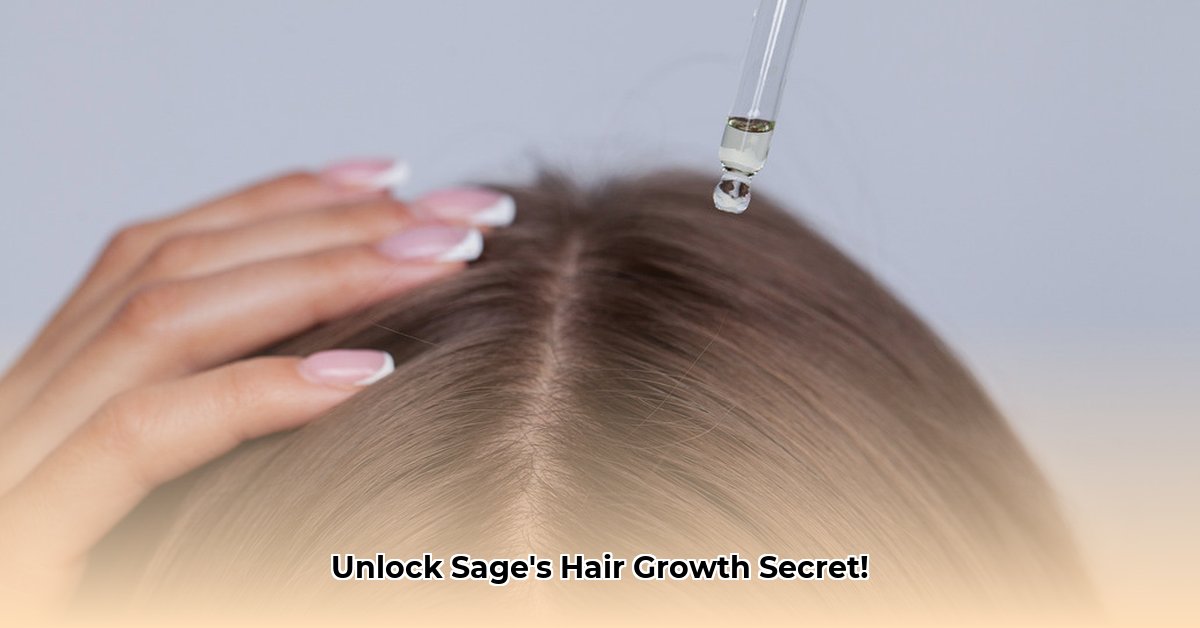
Understanding Sage's Potential for Hair Health
Sage (Salvia officinalis), a culinary herb with a long history, has also been traditionally used for hair care. Its purported benefits stem from its potent blend of properties: antimicrobial action against scalp infections, antioxidant protection against damage, and anti-inflammatory effects to soothe irritated scalps. These characteristics suggest a potential role in supporting hair health by creating a favorable environment for hair follicles. However, while promising, the current scientific evidence isn't conclusive regarding significant, guaranteed hair growth. More research is needed to fully understand its impact. Does this mean sage is ineffective? Not necessarily; it might simply mean results vary person-to-person.
Sage's Key Properties and Their Impact on Hair
The potential benefits of sage for hair are linked to its core components. Antioxidants combat free radicals, protecting hair from damage and maintaining its shine. Antimicrobial properties fight bacteria and fungi that can cause dandruff and scalp infections, contributing to a healthier scalp environment. The anti-inflammatory capabilities can soothe an irritated scalp, potentially reducing inflammation associated with certain scalp conditions. Dr. Anya Sharma, Dermatologist at the Cleveland Clinic, notes, "While anecdotal evidence and some preliminary studies suggest potential benefits, rigorous clinical trials on sage's effectiveness for hair growth are still lacking." This highlights the need for cautious optimism and realistic expectations. Have you ever experienced the soothing effects of a natural remedy? Sage for hair could offer a similar experience.
Different Forms of Sage for Hair Care
Several methods exist for harnessing sage's potential benefits:
- Sage Tea Rinse: This simple, economical method involves brewing dried sage leaves, cooling the tea, and using it as a final rinse after shampooing. It's a gentle approach, suitable for most hair types.
- Essential Oil Treatment: Sage essential oil, when properly diluted, can be massaged directly onto the scalp. This concentrated method offers a potentially more potent delivery of beneficial compounds.
- Commercial Products: Many shampoos and conditioners now incorporate sage extracts. These products offer convenience, but it's vital to check the ingredient list for potential allergens or unwanted additives.
Each method provides different pros and cons regarding ease of use, potency, and potential for irritation. The choice depends on individual preferences and hair type. Do you prefer a DIY approach or the convenience of a pre-made product?
How to Use Sage for Hair: Step-by-Step Instructions
Here are detailed instructions for two popular methods:
1. Sage Tea Rinse:
- Steep 2-4 tablespoons of dried sage in 1 cup of boiling water for 15-20 minutes.
- Cool the tea completely before use.
- After shampooing, pour the tea over your hair and scalp, gently massaging it in.
- Leave it for a few minutes before rinsing thoroughly.
2. Diluted Sage Essential Oil Treatment:
- Mix 2-3 drops of sage essential oil with 1 tablespoon of a carrier oil (e.g., jojoba, coconut).
- Perform a patch test 24 hours before applying to your whole scalp.
- Gently massage the diluted oil into your scalp.
- Leave it for 30 minutes, then shampoo and condition as usual.
Remember, consistency is key – using these methods regularly will yield better results than occasional use.
Precautions and Considerations: Prioritizing Safety
While generally considered safe, sage can trigger allergic reactions in some individuals. Scalp irritation is also a possibility. Therefore, a patch test 24 hours before use is crucial. Pregnant or breastfeeding women, individuals with pre-existing scalp conditions (eczema, psoriasis), or those taking medications should consult a doctor before using sage for hair growth. Always start with a small amount to assess your scalp's tolerance. Did you know that even common herbs can sometimes cause reactions? Prioritizing safety is paramount.
Conclusion: Embracing a Natural Approach
Sage offers a potentially beneficial natural approach to hair care, possibly improving shine, managing dandruff, and potentially stimulating hair growth. However, it's vital to approach its use with realistic expectations and a focus on safety. By following the outlined procedures and prioritizing a patch test, you can explore the potential benefits of this versatile herb for your individual hair care routine. Remember, a healthy lifestyle contributes significantly to hair health.